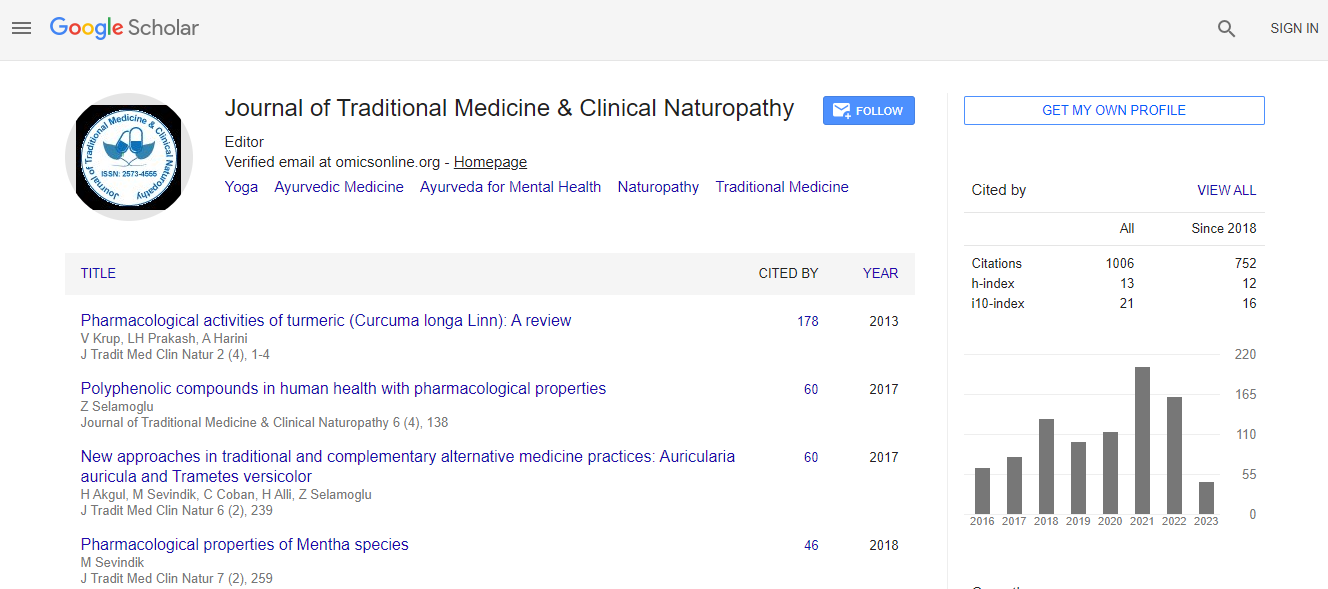Our Group organises 3000+ Global Conferenceseries Events every year across USA, Europe & Asia with support from 1000 more scientific Societies and Publishes 700+ Open Access Journals which contains over 50000 eminent personalities, reputed scientists as editorial board members.
Open Access Journals gaining more Readers and Citations
700 Journals and 15,000,000 Readers Each Journal is getting 25,000+ Readers
Google Scholar citation report
Citations : 1504
Journal of Traditional Medicine & Clinical Naturopathy peer review process verified at publons
Indexed In
- CAS Source Index (CASSI)
- Google Scholar
- Sherpa Romeo
- Open J Gate
- Genamics JournalSeek
- RefSeek
- Directory of Research Journal Indexing (DRJI)
- Hamdard University
- EBSCO A-Z
- Publons
- Geneva Foundation for Medical Education and Research
- Euro Pub
- ICMJE
Useful Links
Recommended Journals
Related Subjects
Share This Page
The application of electroacupuncture in temporomandibular disorders
6th International Conference and Exhibition on Traditional & Alternative Medicine
Aurea Chun-En Kuo
Kaohsiung Chang Gung Memorial Hospital, Taiwan
ScientificTracks Abstracts: J Tradi Med Clin Natur
Abstract
Temporomandibular disorders (TMDs) refer to a group of related pathologies involving the temporomandibular joints, muscles of mastication, and/or associated structures. TMDs are characterized by symptoms such as pain and decreased maximal mouth opening (MMO). Currently, the standard treatment modality for TMDs is nonsurgical management, based on the results of longstanding clinical research studies. However, many alternative approaches to the treatment of TMDs have arisen, primarily due to the frequency of cases that are refractory to traditional nonsurgical intervention. In many clinical studies, acupuncture has been proven an effective form of pain management, particularly pain of musculoskeletal origin, including TMDs. Within the last decade, there has been a substantial increase in the number of research studies addressing the efficacy of electroacupuncture techniques in the treatment of persistent tissue injury, nerve injury, pain associated with cancer, and visceral pain. These studies indicate that electroacupuncture not only reduces both the sensory and affective components of inflammatory pain but also inhibits neuropathic pain. The mechanism by which electroacupuncture blocks pain results from the activation or inhibition of a variety of bioactive chemicals throughout the peripheral, spinal, and supraspinal pathways. This study aims to analyze the effecacy of electroacupuncture as a treatment method for pain associated with TMDs in the scientific literature.Biography
Aurea Chun-En Kuo is a medical Doctor at Kaohsiung Chang Gung Memorial Hospital with experience in Acupuncture and a passion for CAM studies. She has been a Member of Chinese Medical Association of Acupuncture (CMAA) and she obtained the documentation of subspecialty in Chinese Dermatology, Acupuncture, and Coventional Western Medicine. Her research topics focus on CAM in treating chronic tinnitus, modern medical devices for meridian analysis such as Ryodoraku, and the epidemiologic characteristics of CAM nursing in Taiwan. Her recent research interest is the basic research of herbs to be applied in the treatment of cancer and sepsis and CAM syndrome differentiation and treatment.
Email: lecherries@gmail.com

 Spanish
Spanish  Chinese
Chinese  Russian
Russian  German
German  French
French  Japanese
Japanese  Portuguese
Portuguese  Hindi
Hindi 
